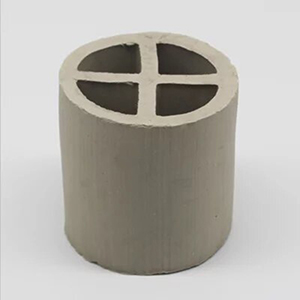Introduction to Ceramic Cross Rings

Ceramic cross rings, also known as ceramic cross-baffle ring packing, are improved from raschig rings by adding a cross baffle inside, forming a cross-shaped port structure. This design increases the specific surface area of the packing, thereby enhancing mass transfer efficiency. Meanwhile, due to the larger specific surface area, ceramic cross rings have higher compressive strength than Raschig rings.
These packings exhibit excellent acid resistance and heat resistance, capable of withstanding corrosion from various inorganic acids, organic acids, and organic solvents except hydrofluoric acid. They have a wide operating temperature range and can be used in both low and high-temperature environments.
Ceramic cross rings are generally large in size and suitable for integral stacking. They are mainly used at the bottom of towers with random packing as a support to hold the distribution layer. With a porosity of over 60%, they can increase the flow rate of gas and liquid through the tower, improving the overall efficiency of the equipment.
Parameter Table of Ceramic Cross Rings
Specification (mm) | Quantity per Cubic Meter (n/m³) | Weight per Cubic Meter (kg/m³) | Specific Surface Area (㎡) | Porosity (%) |
Φ50505 | 6400 | 520 | 135 | 50 |
Φ80808 | 1950 | 800 | 120 | 56 |
Φ10010010 | 1000 | 750 | 110 | 53 |
Φ12012012 | 300 | 860 | 75 | 55 |
Φ15015015 | 295 | 670 | 60 | 58 |
In addition, the chemical composition and physical properties of ceramic cross rings are as follows:
- Chemical Composition: SiO₂>76%, Al₂O₃>17%, Fe₂O₃<1%, CaO<1-2%, K₂O+Na₂O<2-4%, other<1%.
- Physical Properties: Specific gravity 2.25-2.35g/cm³, water absorption <0.5%, acid resistance >99.8%, alkali resistance >85%, firing temperature 1280-1320℃, operating temperature >1200℃, Mohs hardness >6.5.


.jpg)
.jpg)
.jpg)
.jpg)
.jpg)
.jpg)
.jpg)